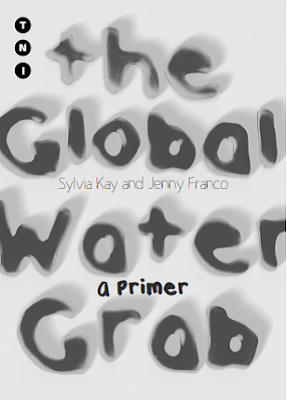One of the areas the
Transnational Institute (TNI) works on is Water Justice. With articles on ‘EC,
stop imposing privatisation of water!’ and ‘Reclaiming Public Water,’ their
website is a great resource for anyone interested in learning more about water
issues and the need for advocacy.
The threat of water
grabbing is very real today. Here’s a section from TNI on the subject of water
grabbing:
Water grabbing refers to situations where powerful actors
are able to take control of or divert valuable water resources and watersheds
for their own benefit, depriving local communities whose livelihoods often
depend on these resources and ecosystems.1 The ability
to take control of such resources is linked to processes of privatisation,
commodification and take-over of commonly-owned resources. They transform water
from a resource openly available to all into a private good whose access must
be negotiated and is often based on the ability to pay. Water grabbing thus
appears in many different forms, ranging from the extraction of water for large-scale
food and fuel crop monocultures, to the damming of rivers for hydroelectricity,
to the corporate takeover of public water resources. It also inheres in a model
of development which is underwritten by a trade in virtual water.
Water grabbing is not a new phenomenon and has much in common
with earlier resource grabs and what has been called the “enclosures of the
commons.” 2
The new dimension of contemporary water grabbing is that the mechanisms for
appropriating and converting water resources into private goods are much more
advanced and increasingly globalised, subject to international laws on foreign
investment and trade. There is thus a real concern that a new generation of
‘Mulhollands’, the early 20th Century Los Angeles official who made water
grabbing infamous, will profit from this scenario to the detriment of local
communities and ecosystems, and at a scale that has not been seen before.(see
Box 1) In the context of a ‘global water crisis’, where 700 million people in
43 countries live below the water-stress threshold of 1,700 cubic metres per
person, there is an urgent need to put an end to the global water grab.3
|
Box 1. A New Mulholland? One hundred years ago
William Mulholland, superintendent of the Los Angeles Water Department,
resolved the city’s water shortage problem through a brutally effective
innovation: a ‘water grab’. By forcibly transferring water used by farmers in
the Owens Valley, more than 200 miles away, he made it possible for Los
Angeles to become one of the fastest growing cities in the United States.
Control of water continues to be a source of great dispute in California,
although nowadays the battles are mainly fought in courts of law. But across
much of the developing world competition over water is intensifying at an
alarming rate, giving rise to intense—and sometimes violent—conflict. The
danger is that the Mulholland model will resurface in a new guise, with
power, rather than a concern for poverty and human development, dictating
outcomes.
Source: UNDP (2006). Human Development Report 2006 -
Beyond Scarcity: Power, Poverty and the Global Water Crisis
|
This article by Jennifer
Franco and Sylvia Kay was originally published on http://www.tni.org
under a Creative Commons Licence: http://www.tni.org/primer/global-water-grab-primer

No comments:
Post a Comment